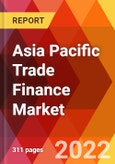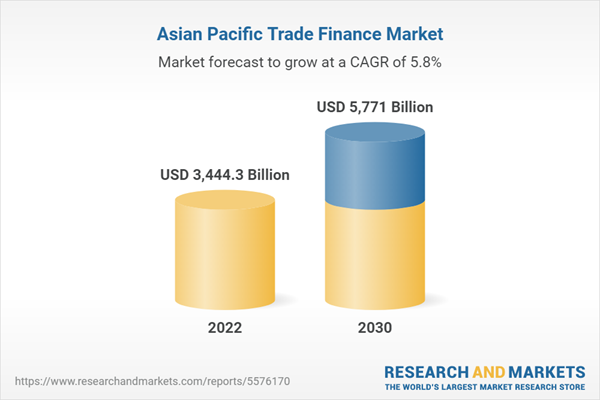The Asia Pacific Trade Finance market held a market value of USD 3,444.3 Billion in 2021 and is projected to reach USD 5,771.0 Billion by the year 2030. The market is anticipated to grow at a CAGR of 5.8% from 2022 to 2030.
Trade Finance concerns with both international as well as domestic trade transactions. The market is expected to be driven by the rapid expansion of BFSI sector in Asia Pacific region coupled with the policy reforms for better integration of SMEs in trade financing. Furthermore, collaboration between government and international institutions for development of digital infrastructure is also estimated to fuel the market growth. Despite the driving factors, heavy use paperwork and documentation in transactions is likely to hinder the market growth.
Policy reforms for better integration of SMEs in trade financing
Cross-border trade digitalization or digitalization and simplification of international trade procedures is expected to help all firms in the Asia-Pacific region, especially the small and medium-sized enterprises (SMEs), which face most amount trade uncertainty. Furthermore, the Framework Agreement on Facilitation of Cross-Border Paperless Trade in Asia and the Pacific - a United Nations treaty is developed by over 25 countries at different development stages. This provided a source for accelerating progress. Therefore, policy reforms for better integration of SMEs in trade financing is expected to boost the market growth.
The Asia Pacific Trade Finance market is segmented into offering, provider type, application, and end user.
The letter of credit (LOCs) segment is expected to account for the largest market share of more than 35% in 2021 owing to their wide usage in commodity trading. The trade loans segment is anticipated to witness the fastest growth rate of around 6.3% during the projected period owing to their increasing demand by exporters, importers, and domestic traders.
The banks segment is estimated to hold the largest share of over 55% of the market in 2021 owing to the high preference of banks for finance related services, including trade finance.
The domestic trade segment is estimated to cross the mark of USD 1,500 billion by 2025 owing to their growing popularity due to no trade restrictions and less transportation cost.
The traders segment held a market opportunity of more than USD 950 billion during 2022 to 2030 owing to the steadily increasing number of traders as compared to the importers and exporters.
By country, the Asia Pacific Trade Finance market is divided into China, India, Japan, South Korea, Australia, ASEAN, and the Rest of Asia Pacific. ASEAN is further classified into Malaysia, Thailand, Philippines, Vietnam, Singapore, Indonesia, and rest of ASEAN.
China is expected to grow at the highest CAGR of more than 6.3% during the projected period owing to the growing awareness regarding trade finance. On the other hand, the ASEAN region is estimated to generate over USD 1,000 billion by 2027 owing to the growing expansion of the BFSI sector in these countries. For instance, HSBC Holdings Plc, Citi bank, and SBC are amongst the top local as well as large players in the Indonesian market.
Major players in the Asia Pacific Trade Finance market include Asian Development Bank, Banco Santander SA, Bank of America Corp., Standard Chartered plc, BNP Paribas SA, Citigroup Inc., Crédit Agricole Group, Goldman Sachs Group Inc., HSBC Holdings Plc, JPMorgan Chase & Co., Mitsubishi UFJ Financial Group Inc., Morgan Stanley, Royal Bank of Scotland, and Wells Fargo & Co., among others.
These market players are engaged in mergers & acquisitions, collaborations, and new product launches, among other initiatives, to strengthen their market presence. For instance, in February 2022, the Asian Development Bank partnered with IIFL Home Finance Limited (IIFL) with a USD 68 million loan for improving financial access to affordable green housing for lower-income women borrowers in India.
Trade Finance concerns with both international as well as domestic trade transactions. The market is expected to be driven by the rapid expansion of BFSI sector in Asia Pacific region coupled with the policy reforms for better integration of SMEs in trade financing. Furthermore, collaboration between government and international institutions for development of digital infrastructure is also estimated to fuel the market growth. Despite the driving factors, heavy use paperwork and documentation in transactions is likely to hinder the market growth.
Growth Influencers:
Policy reforms for better integration of SMEs in trade financing
Cross-border trade digitalization or digitalization and simplification of international trade procedures is expected to help all firms in the Asia-Pacific region, especially the small and medium-sized enterprises (SMEs), which face most amount trade uncertainty. Furthermore, the Framework Agreement on Facilitation of Cross-Border Paperless Trade in Asia and the Pacific - a United Nations treaty is developed by over 25 countries at different development stages. This provided a source for accelerating progress. Therefore, policy reforms for better integration of SMEs in trade financing is expected to boost the market growth.
Segments Overview:
The Asia Pacific Trade Finance market is segmented into offering, provider type, application, and end user.
By Offering
- Supply Chain Finance
- Letters of Credit (LoCs)
- Bonds/ Guarantees/ IndeBnities
- Trade Loans
- Other Services
- Cash Management
- Foreign Exchange Management
The letter of credit (LOCs) segment is expected to account for the largest market share of more than 35% in 2021 owing to their wide usage in commodity trading. The trade loans segment is anticipated to witness the fastest growth rate of around 6.3% during the projected period owing to their increasing demand by exporters, importers, and domestic traders.
By Provider Type
- Banks
- Trade Finance Houses
- Others
The banks segment is estimated to hold the largest share of over 55% of the market in 2021 owing to the high preference of banks for finance related services, including trade finance.
By Application
- Domestic Trade
- International Trade
The domestic trade segment is estimated to cross the mark of USD 1,500 billion by 2025 owing to their growing popularity due to no trade restrictions and less transportation cost.
By End User
- Traders
- Importers
- Exporters
The traders segment held a market opportunity of more than USD 950 billion during 2022 to 2030 owing to the steadily increasing number of traders as compared to the importers and exporters.
Country Overview
By country, the Asia Pacific Trade Finance market is divided into China, India, Japan, South Korea, Australia, ASEAN, and the Rest of Asia Pacific. ASEAN is further classified into Malaysia, Thailand, Philippines, Vietnam, Singapore, Indonesia, and rest of ASEAN.
China is expected to grow at the highest CAGR of more than 6.3% during the projected period owing to the growing awareness regarding trade finance. On the other hand, the ASEAN region is estimated to generate over USD 1,000 billion by 2027 owing to the growing expansion of the BFSI sector in these countries. For instance, HSBC Holdings Plc, Citi bank, and SBC are amongst the top local as well as large players in the Indonesian market.
Competitive Landscape
Major players in the Asia Pacific Trade Finance market include Asian Development Bank, Banco Santander SA, Bank of America Corp., Standard Chartered plc, BNP Paribas SA, Citigroup Inc., Crédit Agricole Group, Goldman Sachs Group Inc., HSBC Holdings Plc, JPMorgan Chase & Co., Mitsubishi UFJ Financial Group Inc., Morgan Stanley, Royal Bank of Scotland, and Wells Fargo & Co., among others.
These market players are engaged in mergers & acquisitions, collaborations, and new product launches, among other initiatives, to strengthen their market presence. For instance, in February 2022, the Asian Development Bank partnered with IIFL Home Finance Limited (IIFL) with a USD 68 million loan for improving financial access to affordable green housing for lower-income women borrowers in India.
The Asia Pacific Trade Finance market report provides insights on the below pointers:
- Market Penetration: Provides comprehensive information on the market offered by the prominent players
- Market Development: The report offers detailed information about lucrative emerging markets and analyzes penetration across mature segments of the markets
- Market Diversification: Provides in-depth information about untapped geographies, recent developments, and investments
- Competitive Landscape Assessment: Mergers & acquisitions, certifications, product launches in the Asia Pacific Trade Finance market have been provided in this research report. In addition, the report also emphasizes the SWOT analysis of the leading players.
- Product Development & Innovation: The report provides intelligent insights on future technologies, R&D activities, and breakthrough product developments
- Industry Outlook: Trade Finance Statistics 2021; Trade Financing Solutions; Trends under Automated Payment Solutions; Top Service Providers for Supply Chain/Trade Finance Platforms, by Country - Digital Solution, Cash Management Solutions; Start-up players in Supply Chain/Trade/Transaction baking Service, By Country; Country-wise Export Value & Import Value, In USD Billion, 2017-2025
- Competitive Dashboard, By Country - China, Singapore, India, Thailand, Japan, Vietnam, South Korea, Indonesia, Australia & New Zealand, Malaysia, and Philippines
The Asia Pacific Trade Finance market report answers questions such as:
- What is the market size and forecast of the Asia Pacific Trade Finance Market?
- What are the inhibiting factors and impact of COVID-19 on the Asia Pacific Trade Finance Market during the assessment period?
- Which are the products/segments/applications/areas to invest in over the assessment period in the Asia Pacific Trade Finance Market?
- What is the competitive strategic window for opportunities in the Asia Pacific Trade Finance Market?
- What are the technology trends and regulatory frameworks in the Asia Pacific Trade Finance Market?
- What is the market share of the leading players in the Asia Pacific Trade Finance Market?
- What modes and strategic moves are considered favorable for entering the Asia Pacific Trade Finance Market?
Table of Contents
Chapter 1.? Research Framework?
Chapter 2.? Research Methodology?
Chapter 4.? Asia Pacific Trade Finance Market Overview?
Chapter 5.? Trade Finance Market Analysis, By Offering?
Chapter 6.? Trade Finance Market Analysis, By Provider Type?
Chapter 7.? Trade Finance Market Analysis, By Application?
Chapter 8.? Trade Finance Market Analysis, By End User?
Chapter 9.? Trade Finance Market Analysis, By Asia Pacific?
Chapter 10.? China Trade Finance Market Analysis?
Chapter 11.? India Trade Finance Market Analysis?
Chapter 12.? Japan Trade Finance Market Analysis?
Chapter 13. South Korea Trade Finance Market Analysis?
Chapter 14.? Australia & New Zealand Trade Finance Market Analysis?
Chapter 15.? ASEAN Trade Finance Market Analysis?
Chapter 16.? Singapore Trade Finance Market Analysis?
Chapter 17.? ASEAN Trade Finance Market Analysis?
Chapter 18.? Company Profile (Company Overview, Financial Matrix, Sales Composition Ration, Key Device Type landscape, Key Personnel, Key Competitors, Contact Address, and Business Strategy Outlook)?
Companies Mentioned (Partial List)
A selection of companies mentioned in this report includes, but is not limited to:
- Asian Development Bank
- Banco Santander SA
- Bank of America Corp.
- Standard Chartered plc
- BNP Paribas SA
- Citigroup Inc.
- Crédit Agricole Group
- Goldman Sachs Group Inc.
- HSBC Holdings Plc
- JPMorgan Chase & Co.
- Mitsubishi Ufj Financial Group Inc.
- Morgan Stanley,
- Royal Bank of Scotland
- Standard Chartered Bank
- Wells Fargo & Co.
Table Information
| Report Attribute | Details |
|---|---|
| No. of Pages | 311 |
| Published | January 2022 |
| Forecast Period | 2022 - 2030 |
| Estimated Market Value ( USD | $ 3444.3 Billion |
| Forecasted Market Value ( USD | $ 5771 Billion |
| Compound Annual Growth Rate | 5.8% |
| Regions Covered | Asia Pacific |









